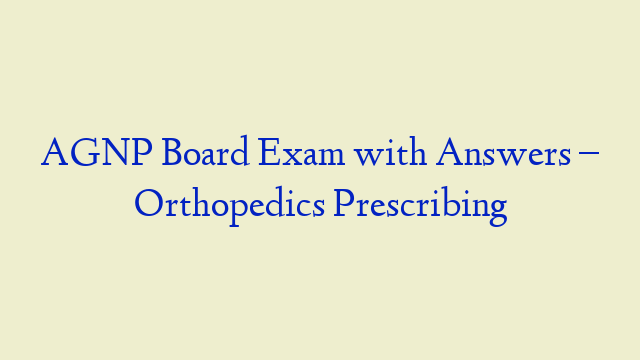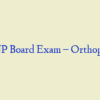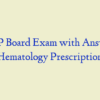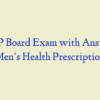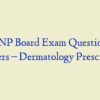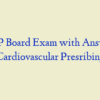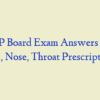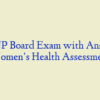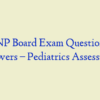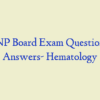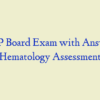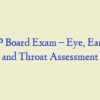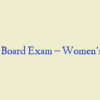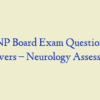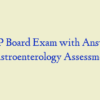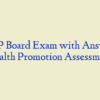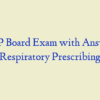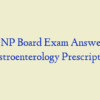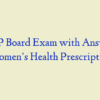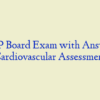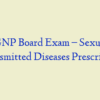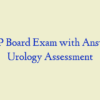Description
AGNP BOARD EXAM QUESTIONS Orthopedics Prescribing (103 Questions)
- Which medication is NOT a brand name for acetaminophen?
- To treat low back pain in a patient for whom nonsteroidal anti-inflammatory drugs (NSAIDs) are contraindicated, the recommended therapy is:
- The patient at highest risk for side effects from cyclobenzaprine (Amrix) is a:
- When assessing a patient with suspected acetaminophen (Tylenol) overdose, the time of ingestion can be confirmed by checking:
- A patient with severe osteoarthritis is complaining of a pain exacerbation due to weather change. Ketorolac should be avoided in this patient due to a drug-drug interaction with:
- The half-life elimination of colchicine (Colcrys), used in the treatment of gout, is approximately:
- Dantrolene (Dantrium) reduces skeletal muscle spasticity by:
- Which formulation of naproxen would result in fewer GI side effects?
- Salicylates, such as aspirin,:
- When evaluating the effectiveness of baclofen (Lioresal), the LEAST appropriate goal is to:
- The concomitant use of aspirin and nonsteroidal anti-inflammatory drugs (NSAIDs) can cause:
- Clindamycin (Cleocin) is NOT indicated for the treatment of serious infections, such as septic arthritis, caused by:
- Intra-articular steroid injections are NOT contraindicated:
- Patients should be instructed to take tizanidine (Zanaflex):
- Before prescribing Dantrolene (Dantrium), a peripherally-acting muscle relaxant, obtain a baseline serum:
- The brand name for cyclobenzaprine is:
- The intra-articular steroid with the longest duration of action is:
- Ketorolac (Toradol), administered intramuscularly, would be indicated for the patient with a complaint of:
- Dosing of acetaminophen (Tylenol) in children weighing less than 50 kg is:
- The maximum FDA-recommended single dose of oral acetaminophen (Tylenol) in an adult is:
- Which medication would NOT be appropriate for the treatment of acute gout?
- A 42-year-old woman was started on naproxen sodium (Aleve) for the treatment of tendinitis in the right ankle. The patient calls 3 days later and reports swelling in both ankles. The nurse practitioner should advise the patient to:
- Oral ketorolac (Toradol) should not be taken for more than:
- Which medication minimizes bone loss, decreasing the risk for osteoporosis?
- In adults with normal renal function, the half-life elimination of naproxen sodium (Aleve) is approximately:
- Which diagnosis is NOT a contraindication to nonsteroidal anti-inflammatory agents?
- Which adverse event is NOT related to colchicine?
- The recommended antidote for acetaminophen toxicity is:
- Symptoms of salicylate (i.e., aspirin) poisoning may include:
- The brand name for tizanidine is:
- Caution is advised with concomitant use of salicylates and:
- Baclofen (Lioresal), used in the treatment of spondylosis, may be administered:
- Patients should be advised to avoid combining tizanidine (Zanaflex) with:
- Patients should be instructed to avoid abrupt withdrawal of baclofen (Lioresal) to prevent the occurrence of:
- The generic name of Toradol, a nonsteroidal anti-inflammatory drug, is:
- NSAIDs should be used with caution in the patient who has:
- Raloxifene (Evista) is indicated for the treatment of osteoporosis. It also:
- Which amount of calcium and vitamin D does the National Osteoporosis Foundation recommend to prevent osteoporosis in women 50 years and older?
- The concomitant use of tizanidine (Zanaflex) and other drugs that inhibit the CYP1A2 enzyme pathway is absolutely contraindicated. Other CYP1A2 inhibitors include:
- The drug of choice for analgesic and antipyretic use during pregnancy is:
- For patients taking tizanidine (Zanaflex), diagnostic testing at baseline and when maximum dose is achieved includes:
- The brand name of dantrolene, a skeletal muscle relaxant, is:
- When treating a fracture, factors that influence acetaminophen (Tylenol) toxicity do NOT include:
- A commonly reported side effect of tizanidine (Zanaflex), a skeletal muscle relaxant, is:
- The recommended interval between subacromial intra-articular steroid injections is:
- A potential side effect related to the use of ketorolac (Toradol) is:
- Ketorolac (Toradol), a nonsteroidal antiinflammatory drug, reduces pain by:
- Two black box warnings for ibuprofen (Motrin) include increased risk for:
- When corticosteroids are used in combination with nonsteroidal anti-inflammatory drugs (NSAIDs), patients may develop:
- Naproxen (Aleve) is NOT indicated for relief of signs and symptoms associated with:
- In a 50-year-old nondiabetic man with moderate inflammation secondary to septic bursitis, the most appropriate therapy is:
- Ketorolac (Toradol), a nonsteroidal anti-inflammatory drug, is:
- Allopurinol (Zyloprim) is NOT indicated for the treatment of:
- The risk for gastrointestinal bleeding may increase with concomitant use of ibuprofen (Motrin) and:
- Patients who have difficulty swallowing tizanidine (Zanaflex) capsules should be:
- Cyclobenzaprine (Fexmid) should not be administered concomitantly with:
- Colchicine (Colcrys) is an alkaloid that is:
- The maximum recommended daily dose of acetaminophen (Tylenol) for the management of pain associated with a clavicular fracture is:
- Baclofen (Lioresal), a centrally-acting muscle relaxant, is indicated for the treatment of:
- The generic name for Advil, sometimes used in the treatment of joint pain, is:
- Initial monotherapy for the treatment of low back pain is:
- Which muscle relaxant is monitored by the Drug Enforcement Agency and is listed as a Schedule IV medication?
- When administering allopurinol (Zyloprim) for the treatment of gout, it is important to instruct the patient to:
- Probenecid, used in the treatment of gout, works by:
- The medication initially recommended to control pain associated with non-inflammatory osteoarthritis is:
- Brand names for naproxen, a nonsteroidal anti-inflammatory drug, do NOT include:
- Which medication helps the kidneys excrete uric acid?
- Corticosteroids, sometimes prescribed to reduce inflammation related to rheumatoid arthritis, should NOT be given in combination with:
- Which of the following is NOT classified as a muscle relaxant:
- The use of carisoprodol (Soma) should be limited to 2-3 weeks, mostly due to the potential for:
- Clindamycin (Cleocin) is indicated for the treatment of serious infections of:
- Which of the following is NOT a reason to discontinue allopurinol (Zyloprim)?
- Prior to initiating pharmacologic therapy for the treatment of osteoporosis, the nurse practitioner should evaluate baseline serum:
- The term systemic corticosteroids refers to corticosteroids that are:
- Acetaminophen (Tylenol) works to reduce pain by:
- Patients who are taking bisphosphonates (i.e., alendronate [Fosamax]) for osteoporosis should be advised to:
- Ketorolac (Toradol), for the treatment of moderate pain, is classified as a(n):
- Allopurinol (Zyloprim), used in the treatment of gout, decreases serum uric acid by:
- Acetaminophen (Tylenol) is contraindicated in patients who have:
- Cyclobenzaprine (Fexmid), a skeletal muscle relaxant, should not be taken consistently for more than:
- Ibandronate (Boniva), a biphosphonate, is approved for:
- The generic name for Indocin, used in the treatment of gout, is:
- Baclofen (Lioresal), a centrally-acting muscle relaxant, is indicated for the treatment of symptoms related to:
- The most common adverse reaction to cyclobenzaprine (Fexmid) is:
- The onset of analgesic action of naproxen sodium (Aleve) occurs within:
- Bisphosphonates, used in the treatment of osteoporosis,:
- The most significant adverse reaction associated with the overuse of acetaminophen (Tylenol) is:
- Acetaminophen (Tylenol) for the treatment of osteoarthritic pain is classified as a(n):
- The generic name for Lioresal is:
- Acetaminophen (Tylenol) does NOT produce:
- The mechanism of action of NSAIDs is to:
- The maximum daily dose of ibuprofen (Motrin), sometimes used for relief of moderate low back pain, is:
- Cyclobenzaprine (Fexmid) and tizanidine (Zanaflex) are classified as:
- The generic name for Robaxin is:
- Cyclobenzaprine (Fexmid), a skeletal muscle relaxant, is indicated in the treatment of:
- Patients taking acetaminophen (Tylenol) should be advised to avoid:
- The most common side effect associated with ketorolac (Toradol) for the treatment of moderate musculoskeletal pain is:
- Caution is advised with the concomitant administration of angiotensin-converting enzyme (ACE) inhibitors and nonsteroidal antiinflammatory drugs (NSAIDs) because:
- NSAIDs potentiate the effects of ACE inhibitors, causing hypotension.
- The best initial medication for the treatment of acute gout in the great toe of a patient with a creatinine clearance of 50 mL/min is:
- Glucocorticoids, sometimes used to treat rheumatoid arthritis,:
- The generic name for Soma is:
- A nonsteroidal anti-inflammatory drug (NSAID) that can be administered orally and intramuscularly is:
- Oral ibuprofen (Motrin) has a bioavailability of:
